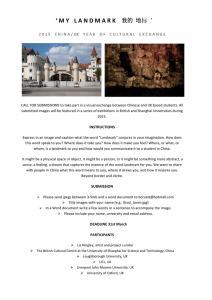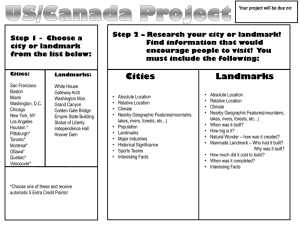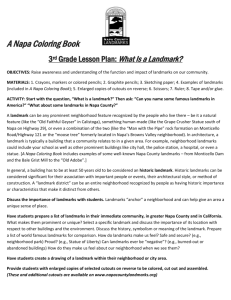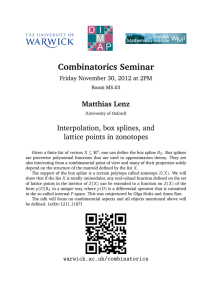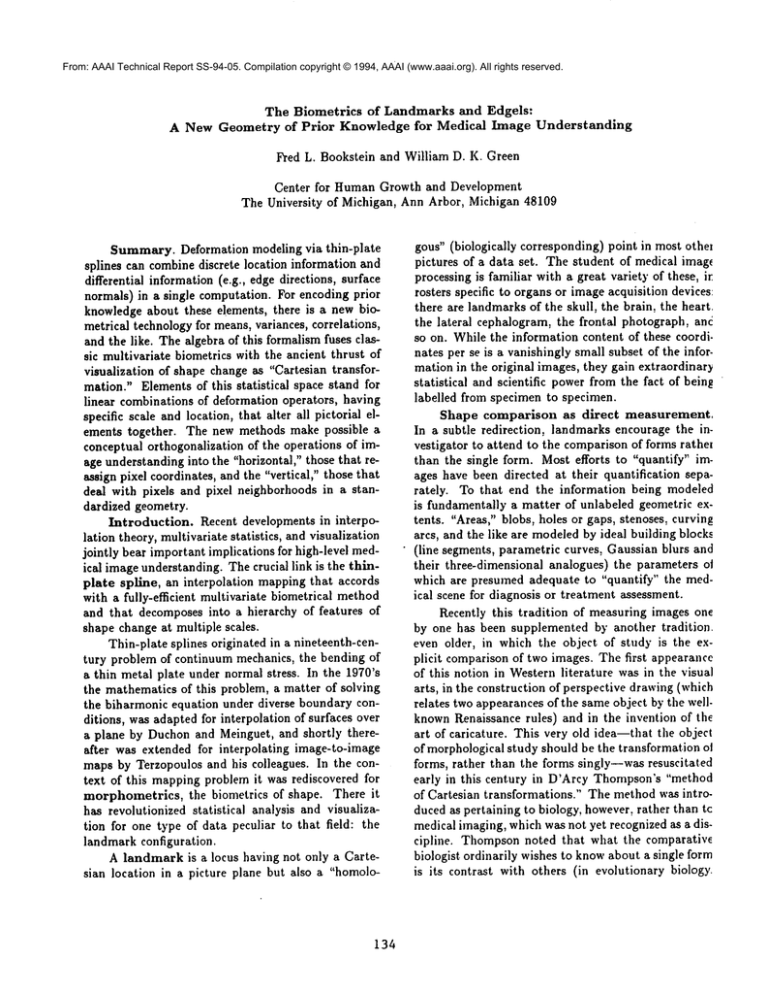
From: AAAI Technical Report SS-94-05. Compilation copyright © 1994, AAAI (www.aaai.org). All rights reserved.
A New Geometry
The Biometrics
of Landmarks and Edgels:
of Prior Knowledge for Medical Image Understanding
Fred L. Bookstein and William D. K. Green
Center for Human Growth and Development
The University of Michigan, Ann Arbor, Michigan 48109
Summary. Deformation modeling via thin-plate
splines can combine discrete location information and
differential information (e.g., edge directions, surface
normais) in a single computation. For encoding prior
knowledge about these elements, there is a new biometrical technology for means, variances, correlations,
and the like. The algebra of this formalism fuses classic multivariate biometrics with the ancient thrust of
visualization of shape change as "Cartesian transformation." Elements of this statistical
space stand for
linear combinations of deformation operators, having
specific scale and location, that alter all pictorial elements together. The new methods make possible a
conceptual orthogonalization of the operations of image understanding into the "horizontal," those that reassign pixel coordinates, and the "vertical," those that
deal with pixels and pixel neighborhoods in a standardized geometry.
Introduction.
Recent developments in interpolation theory, multivariate statistics, and visualization
jointly bear important implications for high-level medical image understanding. The crucial link is the thinplate spline, an interpolation mapping that accords
with a fully-efficient multivariate biometrical method
and that decomposes into a hierarchy of features of
shape change at multiple scales.
Thin-plate splines originated in a nineteenth-century problem of continuum mechanics, the bending of
a thin metal plate under normal stress. In the 1970’s
the mathematics of this problem, a matter of solving
the biharmonic equation under diverse boundary conditions, was adapted for interpolation of surfaces over
a plane by Duchon and Meinguet, and shortly thereafter was extended for interpolating image-to-image
maps by Terzopoulos and his colleagues. In the context of this mapping problem it was rediscovered for
morphometrics, the biometrics of shape. There it
has revolutionized statistical
analysis and visualization for one type of data peculiar to that field: the
landmark configuration.
A landmark is a locus having not only a Cartesian location in a picture plane but also a "homolo-
134
gous" (biologically corresponding) point in most othel
pictures of a data set. The student of medical imag~
processing is familiar with a great variety of these, ir
rosters specific to organs or image acquisition devices:
there are landmarks of the skull, the brain, the heart.
the lateral cephalogram, the frontal photograph, anc
so on. While the information content of these coordi.
nates per se is a vanishingly small subset of the information in the original images, they gain extraordinary
statistical and scientific power from the fact of bein~
labelled from specimen to specimen.
Shape comparison as direct
measurement.
In a subtle redirection, landmarks encourage the investigator to attend to the comparison of forms rathel
than the single form. Most efforts to "quantify" images have been directed at their quantification separately. To that end the information being modeled
is fundamentally a matter of unlabeled geometric extents. "Areas," blobs, holes or gaps, stenoses, curvin~
arcs, and the like are modeled by ideal building block~
(line segments, parametric curves, Gaussian blurs and
their three-dimensional analogues) the parameters ot
which are presumed adequate to "quantify" the medical scene for diagnosis or treatment assessment.
Recently this tradition of measuring images one
by one has been supplemented by another tradition.
even older, in which the object of study is the explicit comparison of two images. The first appearance
of this notion in Western literature was in the visual
arts, in the construction of perspective drawing (which
relates two appearances of the same object by the wellknownRenaissance rules) and in the invention of the
art of caricature. This very old idea--that the object
of morphological study should be the transformation ol
forms, rather than the forms singly--was resuscitated
early in this century in D’Arcy Thompson’s "method
of Cartesian transformations." The method was introduced as pertaining to biology, however, rather than tc
medical imaging, which was not yet recognized as a discipline. Thompson noted that what the comparative
biologist ordinarily wishes to knowabout a single form
is its contrast with others (in evolutionary biology.
the ancestor; in medicine, the "normal" or "typical").
This "transformation" or "deformation," he went on,
may be displayed as an explicit mensurand by imagining the one form to have deformed a Cartesian grid
squared over the picture of the other. The parameters
of the proper object of shape analysis, the comparison of shapes, pertain not to the bulges or corners or
notches of the single form, but to the transformations
of the picture plane, or of the three-dimensional space
of the organism, that grasp this comparison directly.
The two-dhnenslonal
interpolating
spline.
Thompson’sillustrations,
which were all hand-drawn,
were hmous but frustrating. Generations of quantitative biologists tried and failed to provide a formalism
for these maps that permitted their description other
than in words. Not until quite recently did we find,
in the thin-plate spline, a suitably flexible set of parametric mappings. The thin-plate spline interpolant
supplies a smooth surface through any combination of
heights over any combination of knots in a base plane.
In morphometrics, the coordinates of any one set of
landmark locations are treated as "heights" above the
picture of the landmark locations in any other form.
The relation between any two configurations of correspondingly labelled landmark locations combines two
thin-plate splines on the same set of knots, which are
taken as the locations of the landmarks in one of the
forms. One of these splines uses as its "heights" the
z-coordinates of the landmark locations in a second
configuration, and the other spline the ~/-coordinates
of that same second set of landmarks. There results
a model of the landmark reconfiguration as a deformation that takes the whole of the picture plane of
one of the sets of landmarks onto the picture plane
of the other, a mappingin which every pair of correspondingly labelled landmarks corresponds and which
is pleasantly (indeed, optimally) smooth in-between.
Shape space: statistics
for landmarks. At
this point in our story I must briefly digress to bring in
another theme: the shape space of a set of landmarks
that vary modestly around a typical form. A statistical
geometry, David Kendall’s "shape space" places a descriptive structure atop our landmark shapes prior to
any biological or medical considerations at all. This
shape space is a metric space, with distance closely
related to the so-cMled "Procrustes distance," the
summedsquared distances between all pairs of corresponding landmarks when one form is translated,
rotated, and scaled over the other so as to minimize
that very sum. By the middle 1980’s it was known
that the complete multivariate statistical analysis of
135
a set of landmarks could be carried out in this space,
using only coordinates of the original forms, with no
representation of particular features of shape required.
Using this machinery, statisticians
could average
shapes and test for differences or correlations, but they
had no way to visualize their findings. Welearned
quickly that all the obvious approaches--sketches of
distances or ratios, shapes of selected polygons, etc.-led to inconsistent interpretations in most practical applications. The splines not only supply a visualization
of the interpolation, a solution of D’Arcy Thompson’s
old problem, but also provide the multivariate "shape
space" of the landmark locations a very useful new
basis. As applied to two-dimensional data, one feature plane is reserved to represent the aftine transformations, the uniform shears whose derivatives are the
same everywhere. The remaining dimensions span the
nonuniform transformations, those having derivatives
that vary from point to point. These feature planes
are determined by further exploiting the analogy between the deformation of images and the bending of
plates. Any spline of an actual plate has a bending energy, the physical energy required to bend an
infinite, infinitely thin, initially flat metal plate into
the specified form. By extension, any deformation of
a landmark configuration modeled in this way has a
bending energy, the sum of the energies of its two
"plates." The features we use for decomposing deformations of landmarked shapes’are the principal
warps, the eigenfunctions of the bending energy with
respect to ghe Procrustes distance serving as the metric for Kendall’s shape space. Because relative vertical
displacement between adjacent landmarks requires less
energy as the landmarks are separated, these eigenvectors emerge ordered by an effective "geometric scale"
for each feature. Bookstein (1991) explains this approach to biometrics in considerable detail.
Using outline information
in the interpolation function. In this new tradition,
landmarks
encode the lowest level of primitive observations: The
paired positions of the same landmark in two forms
constitute a most petite sample of the transformation
in question. Even should we choose to restrict our attention to so discrete a sample of the mapping, the
parameters of the transformations we seek to measure
would derive not from single landmark configurations
but from pairs of landmark configurations. A better
set of parameters would make use of information about
the matching (the homology) of both landmarks and
curves; a still better set would make use of information about matching of points on surfaces. The best
possible
setwoulduseinformation
aboutthematching
function,
stilltherawmensurand,
at everyvoxelof an
extended
three-dimensional
image.
Overthelasttenyears,
thisapproach
tothe"measurement"
of singletransformations
hasramified
in
severalcentersof medicalimageanalysis.
The role
of distributed
information
in specifying
deformations
has beenmostintensively
studiedby Grenander
and
Miller
andtheircolleagues,
whocouchtheiralgorithms
in termsof diffusion
or jump-diffusion
in a spaceof
"patterns."
Thediffusion
is controlled
in partby a
drift term analogous to the energy term minimized
in the spline approaches. Another group working on
the empirical estimation of deformations, Evans’ at
the Montreal Neurological Institute, carries out distributed computations in hierarchical form, from top
to bottom of a discrete scale space of Gaussianly blurred images. At each scale, the "landmarks" are the
centers of the quadrats of the equivalent pyramid.
To date, however, none of these approaches have
been extended to the manipulations and operations
typical of quantitative biomedical science--comparison of group means, correlation of form with its causes
or consequences, extrapolation or interpolation of series. For instance, Grenander and Miller diffuse one
picture, the "text-book" T, atop another, the "study"
S, so as to minimize a combination of elastic energy
and squared pixel-by-pixel difference after registration.
The warping that results has no convenient analytic
form and no "features"--no straightforward expression
in terms of a small number of parameters.
Outlines have a multivariate statistics all their
own, based on various primitive measures of "distance"
between forms that do not much accord with notions
of biological correspondence. Furthermore, it is typically mucheasier for automatic algorithms to acquire
outlines than to acquire landmark locations. Thus, although the multivariate methods for analysis of landmark locations are remarkably powerful, the data to
which they apply are not typical of most applications
of image analysis. Wecould bridge this gap if we could
adapt the multivariate statistics of landmarklocations
to the richer data sets that are achievable by automatic
or semiautomatic image processing.
Extending the splines to information about
derivatives.
The final synthesis of these two approaches arose only in 1991, when we discovered that
the ordinary thin-plate spline based on landmarks remained algebraically well-behaved as pairs of landmarks of the "starting" form approached each other
more and more closely. In a brief flurry of proceedings
136
papers, we produced all the matrix algebra necessary
to extract these limiting forms of the spline as singu.
lar perturbations of the original spline form. A shape
change that shifted landmark locations and bulged an
outline around them, for instance, would be modeled
as the spline for the shift of landmarks together with
the (mathematically orthogonal) spline for the moreor-less-local twisting of the outline around landmark~
nowfixed in location.
In this way, Kendall’s metric construction for a
landmark-driven shape space is supplemented by a
completely orthogonal space for derivative information, for which the metric is a version of the Procrustes
(distance-based) metric adapted to apply to differentials of mapsnear the identity. Just as the features ot
landmark shape are a function of the mean landmark
form, so the features of "landmark-and-edge shape"
are a function of the mean landmark form along with
its average edges or other representations of derivative.,
of the interpolation map that will be constrained by
data. The multivariate statistical
technology of shape
averaging, correlating, etc., and the visualization ot
effects on shape by principal warps at a hierarchy o!
scales and localizations,
are augmented without any
substantial change.
Edgels, warps, templates.
To any collection
of images having a well-characterized
mean landmark
configuration and typical orientations of edge elements
at some subset of these landmarks, the new morphometric technology supplies a feature space fully reflecting all these features and generated entirely automatically. Easily evaluated by finite matrix operations, the
associated maps apply quite flexibly to instantiate arbitrarily detailed "templates" deriving from typical or
validly averaged images rather than from simple geometric models. To each landmark and each derivative
can be associated a scale of Gaussian blur at which
it is computed. This combination of scales of individual features alongs’ide scales of the eigenfunctions ot
the splines they drive supplies a remarkably rich new
vocabulary for describing salient patterns of scenes.
The same technology that warps templates can
be applied to unwarp specimen images into a normative coordinate system in which grey-level features can
be extracted with great precision of biological localization. The unwarped images may" be averaged pixelwise
to serve as group summaries or as templates informing primary processing routines. The feature spaces
for geometry meanwhilearchive that part of the information in a form usable for conventional multivariate
analyses: assessments of correlations between land-
mark locations and outline form, comparisonor discriminationof groups, structure-function correlations,
and the like. For applications to automatic feature
extraction from images processed individually, these
same parameters, along with the averaged pictures,
supply a convenient basis in whichto express posterior distributions summarizingthe expectedvalues and
the expectedcovariancesof these descriptors. Thereis
one arbitrary constant involved, the "scale" at which
derivative informationis to align with the finite information from rearrangement of discrete landmarks. In
this way, the methodof edgel-driven splines here supports not only a flexible visualization of deformations
but also a completemultivariate statistical method.
"Vertical" and "horizontal" variation of images with landmarks. The problems we are pursuing originate in data that are already visualized. The
source of information was a medicalimage, indicating
a physical property (somesort of interaction with radiation) within each of a grid of little volumesinside
a region of tissue. Ourscientific concernis to investigate aspects of this sort of data manysets at a time;
the concernof AI is to encodean intelligence by which
this task maybe effectively managed.Hencethe job
is at root to concentratecertain features of relevance
to causesor effects out of the extremelydilute information that is each original medical scan. The goal
nowis to retrieve not what is uniqueof each instance
but what is common
to most but not all, what is most
variable amongthem, what typically covaries with exogenouscausesor effects, etc.
Medicalimagesare organizedon Euclideanprinciples, as pixels or voxels. Let us refer to operationsthat
use pixel locations for the index set as vertical. There
is alwaysadditional information,then, in the horizontal part of this index set: informationabout wherethe
labelled locations and gradients of the groundplane actually lie with respect to the pixels, andhowtheir configurations covary with the pictorial content "above"
them. In this context, merely linear diagramsof the
vector space indexedby pixels hardly deserve the name
of "visualization" at all. Whenever
biometric data are
originally visual, the pixel-index machinerymust be
supplemented,if not wholly supplanted, by a semantics of deformation.Thelabelled points and directions
can moveabout in their Euclideandomainat the same
time that images change above them, leading to decompositionsof the variance "at" a point that are very
interesting both cognitivelyand scientifically.
In somestudies, shape of the configuration of labelled points is treated as nuisancevariation. Control-
137
ling this variation increases the precision with which
other effects can be addressed. That is, one analyzes
vertically--examiningthe gradients of the picture, for
instance, or its correlations with physical or biological processes--only after unwarpinghorizontally to a
more focused feature space in which processes vary
less in location or extent. The experience of generations of anatomists shows howthis maneuver improves the powerof subsequent multivariate tactics,
such as discrimination or analysis of covariance. But
in most applications this horizontal variation is not
merely noise or nuisance; it is a signal in its own
right. In the vicinity of their meanconfiguration, the
labelled points and edgels induce a very powerfullowdimensional feature space. With the aid of a convenient basis for shape variation this information may
be concentrated into linear features of its own.Visualization of vectors in this feature space of edgeinformation at landmarksis at least as straightforward as
visualization of changes in surfaces above the planes
or volumes tagged by those points. The combination
of features of labelled point shape with features of the
imageat the average shape--the careful separation of
vertical from horizontal variation in these mixedfeature spaces, along with the careful, specialized visualization of the horizontal--is a very powerfultool toward the automatic understanding of biometrical images and towardscientifically effective automaticprocessing.
Acknowledgement. Preparation of this paper
was supported in part by NIHgrants AA-09009and
GM-37251
to Fred L. Bookstein.
For further
reading
Space is short here. The morphometricsynthesis for landmarks,including the role of the thin-plate
spline and its eigenfunctions, is coveredin F. L. Bookstein, MorphometricTools for LandmarkData, Cambridge University Press, 1991. Its extension to derivative information is set out in F. L. Bookstein and
W. D. K. Green, "A Feature Space for Edgels in Images with Landmarks,"J. MathematicalImaging Vis.
3:231-261,1993, and "A thin-plate spline for deformations with specified derivatives," pp. 14-28 in Mathematical Methodsin Medical Imaging II, Proc. SPIE
2035, 1993. The alternative approach of Grenander
and Miller is described in U. Grenanderand M. Miller,
"Representation of Knowledgein ComplexSystems,"
J. Royal Statistical Society B, 1994, to appear. Many
moresources are cited in these four.


